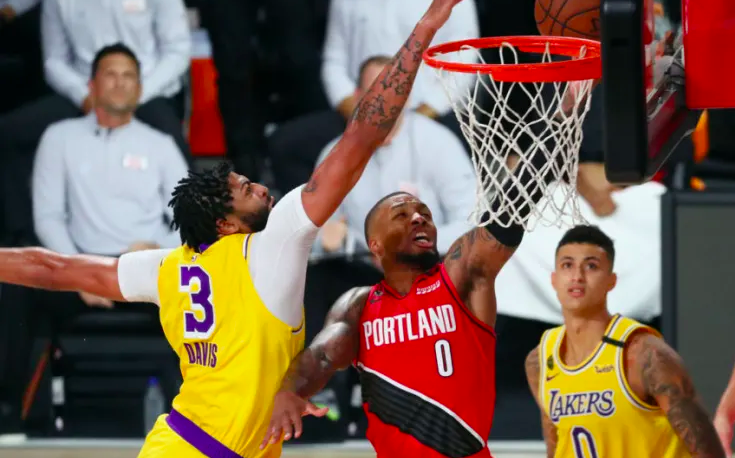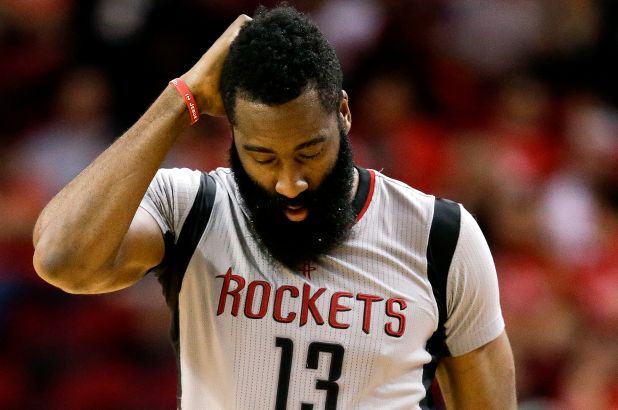2-1 LA. We saw some adjusting, some adjusting to that adjusting, Portland finding hope, and LA dominating in small lineups and with the Caruso/Davis pick & pop to take over the game. Let’s dig in.
Portland’s Offense
Set Plays
We saw the lowest usage of these sets of any game this series, so we won’t spend much time on them. For background on what’s going on for these, check out any of my first three articles on this series.
- Mover-Blocker: ran once; Green went under the flare, which we’ve talked about in 3 pieces already as being the wrong way to cover it. First time it’s happened all series but it led to 3 points for Portland
- Double Fist: ran once, and because LA hard hedged both screens Dame passed to Nurkic on the short roll and he got blocked on a floater attempt
- Step Up Ball Screens: ran 3 times; got a kick out for an open 3 that was missed, Dame couldn’t turn the corner on Kuz, and once where Nurkic threw an interception trying to pass. They ran this a couple more times but just had complete whiffs on the screen.
Dame Lillard Pick & Roll
Dame had 18 total ball screens, or 21 if you count the 3 handoffs he also ran. LA hard hedged (with a weak if he tried to go left) 19 times, and conceded 13 points on those possessions. Switches from pick & pops with Melo also resulted in 2 switches that yielded 5 points.
Overall, 18 points on 21 possessions is a result I’m happy with as LA.
If it wasn’t clear already, LA has figured out the pick and roll for Portland. We see this in Dame’s results against hard hedges:
Dame vs a Hard Hedge Update
Game 1: 15 points for POR in 23 possessions
Game 2: 13 pts 19 poss
Game 3: 13 pts 19 poss
Series Overall: 41 pts 61 pos, 0.67 PPPVs blown coverages and drops: 1.9 PPP
?️?️ The book it out ?️?️
Here were my notes on not dropping pre-series: pic.twitter.com/36MeBD2nd3
— Cranjis McBasketball (@Tim_NBA) August 24, 2020
We also see this in Portland’s offense on pass outs from the pick and roll:
Here's Portland's shot chart this series for shots taken after passouts from the pick & roll and isolation.
Some notable shooting:
CJ 18/35 shooting
Dame 8/33 shooting
Melo 4/16 shooting
Trent 3/12 shootingMcCollum's the only reason this chart isn't almost all blue (misses). pic.twitter.com/zaY63bV10f
— Cranjis McBasketball (@Tim_NBA) August 24, 2020
Even when POR went to handoffs, which had been successful in game 2 due to LA not hedging, LA hedged and was able to handle those situations well. Simple adjustment from LA defensively to Portland going to something that saw some success in game 2.
For the third game in a row, Portland wasn’t finding answers in this regard in any tangible way. I question their ability to suddenly do so in game 4. But if they don’t, this series is over.
CJ McCollum Pick & Roll
CJ ran 17 total ball screens in game 3. Portland scored 12 points in those 17 possessions (0.71 PPP), which is great defense for LA. We saw game 2s shift away from the drop coverage in game 1 towards hard hedges continue this game, with a few switches mixed in when Portland used Melo pick and pops to force those switches.
One note for Dwight would be to put his hands up when trying to contest shots. A hard hedge without a contest on the pull up shots is almost as poor as just running drop coverage.
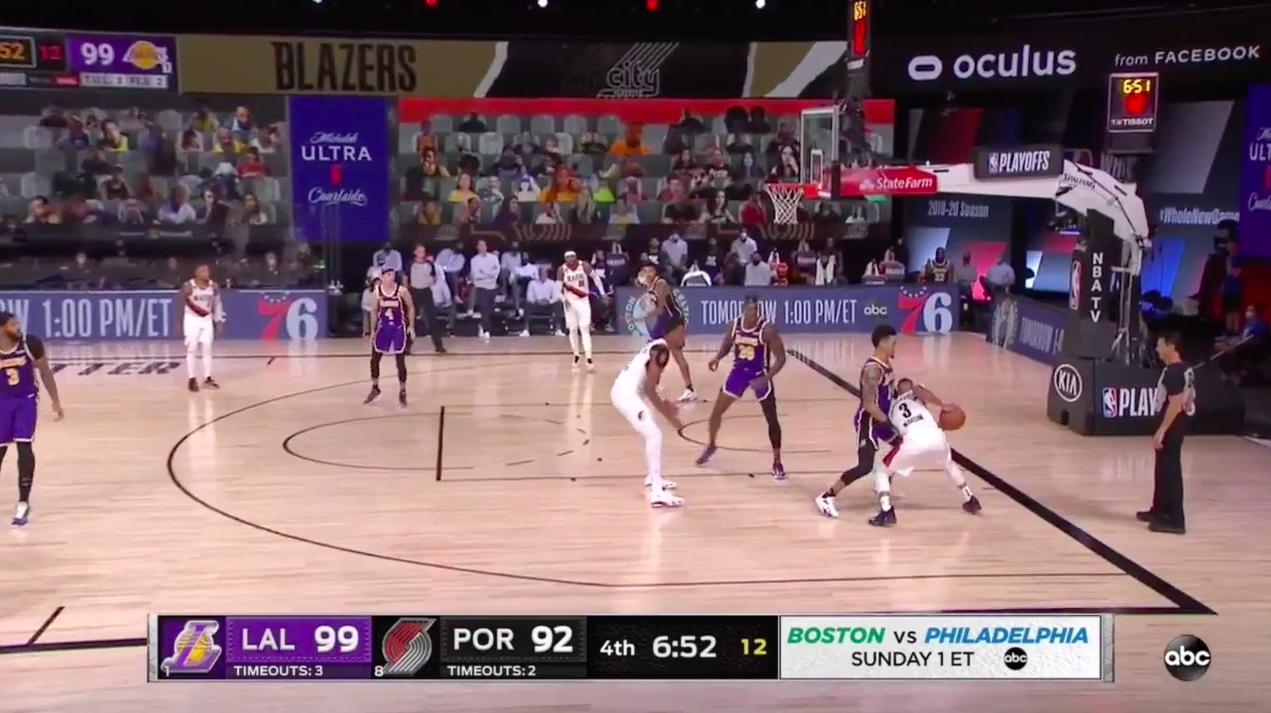
We also saw some more bad defense from JR Smith, who didn’t force CJ to actually use the ball screen and got burned with a reject. That’s particularly deadly when LA is hard hedging instead of dropping, because the big man in that situation also becomes completely out of the play.
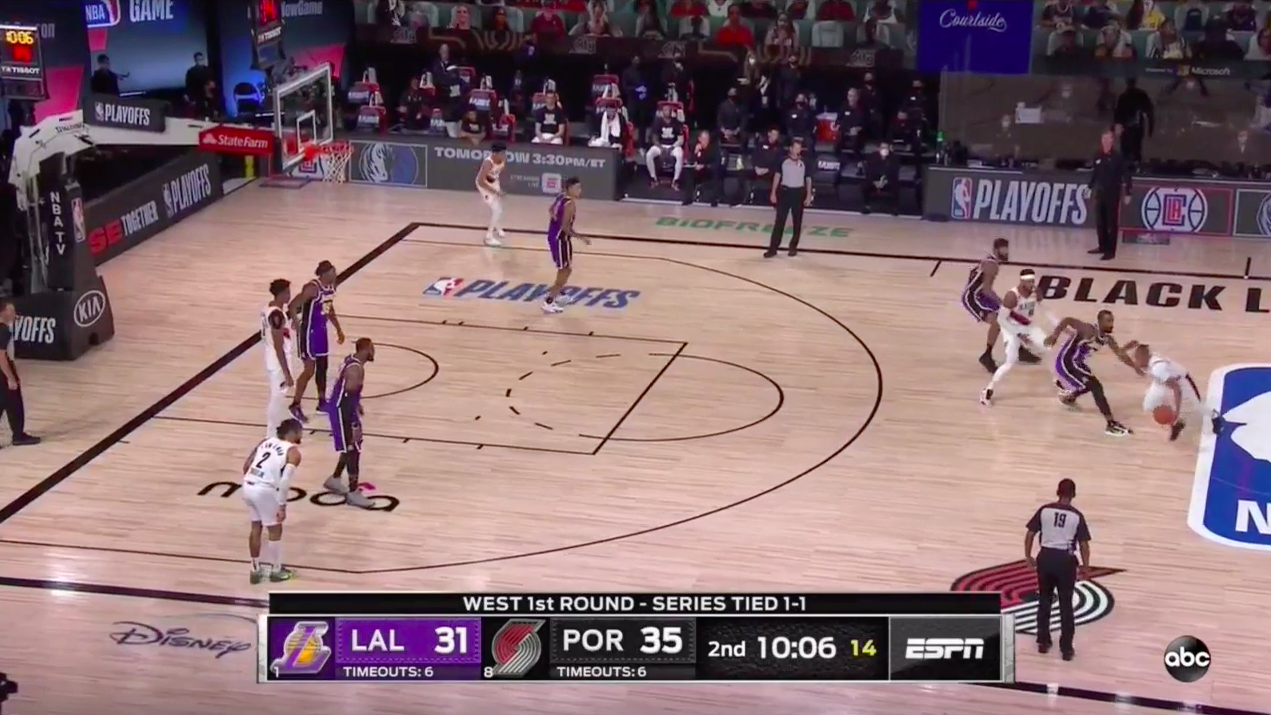
But I have no real notes other than seeking better execution from those two. 9 points conceded on 12 hard hedges is solid defense.
A theme from Portland this game was more isolation for Dame and CJ, and we saw that extend into their pick and roll attack. On 5 possessions, we saw a Laker switch forced by a Melo pick & pop. Portland only scored 3 points on those 5 possessions, which is a good result, but that option will exist for Portland moving forward (and was what I recommended pre-series on a Melo pick & pop) to create more isolation offense for Portland, unless you want to blitz or hard hedge and give up open catch & shoot 3-point attempts for Melo (you shouldn’t want to).
Portland Found an Answer
Two plays in a row mid second quarter the Blazers ran a set that answered all the issues LA had presented their offense. Twice they got scores. Then they went back to the play once more in the 4th quarter and then never again.
Here’s what the play looked like. This first time, LA didn’t switch the big/big screen and there was no hedge, so Melo got a wide open 3-point look.
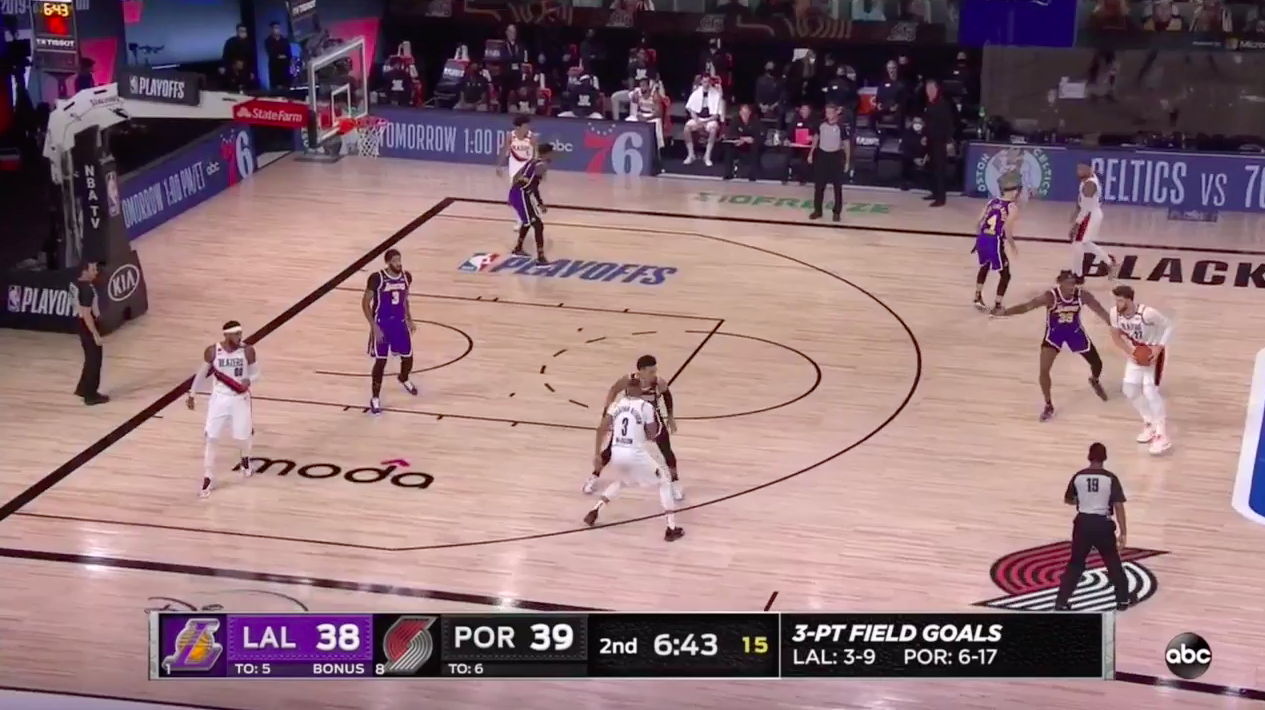
That didn’t happen again. What did happen was LA hedged that screen, so Nurkic rolling after seeing the down screen was wide open, and in a position that even he likely won’t struggle to convert on moving forward. Roll type situations with Nurkic catching at the block instead of above the elbow should be a priority for Portland.
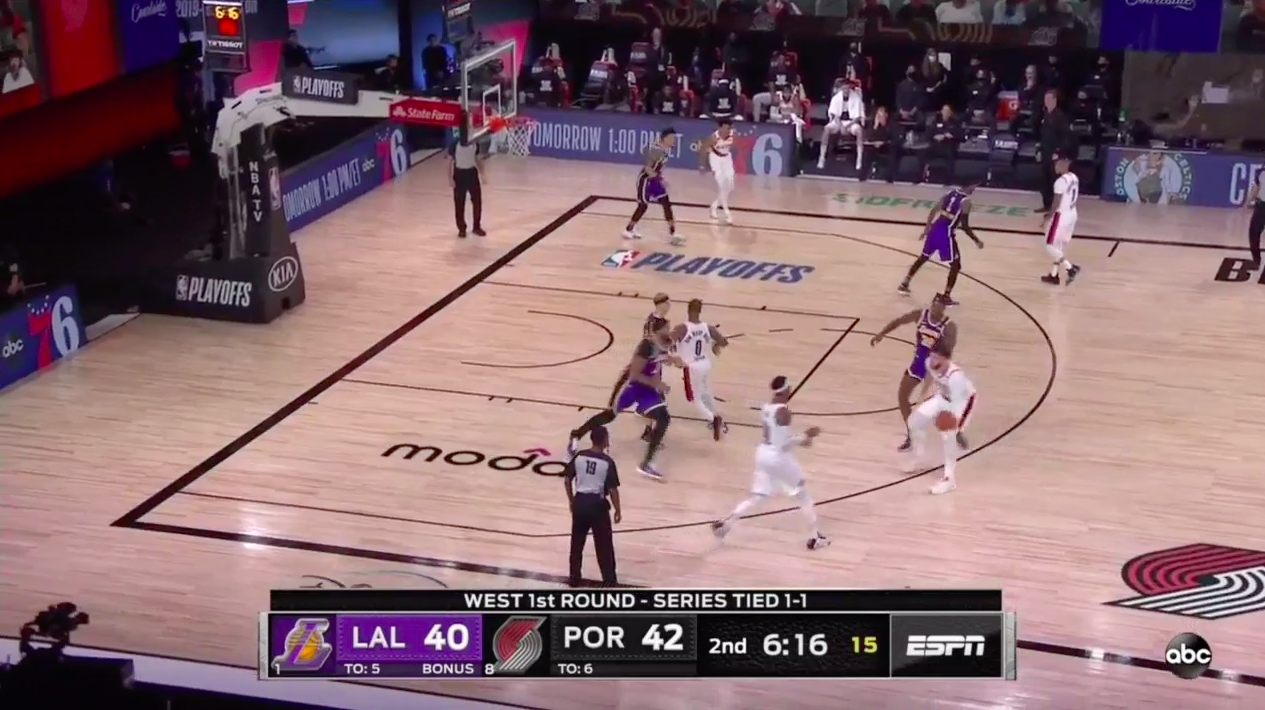
On the third attempt, LA hedged again and Nurkic was wide open for a lob that Melo just didn’t throw. But yet again, the play generated an open look.
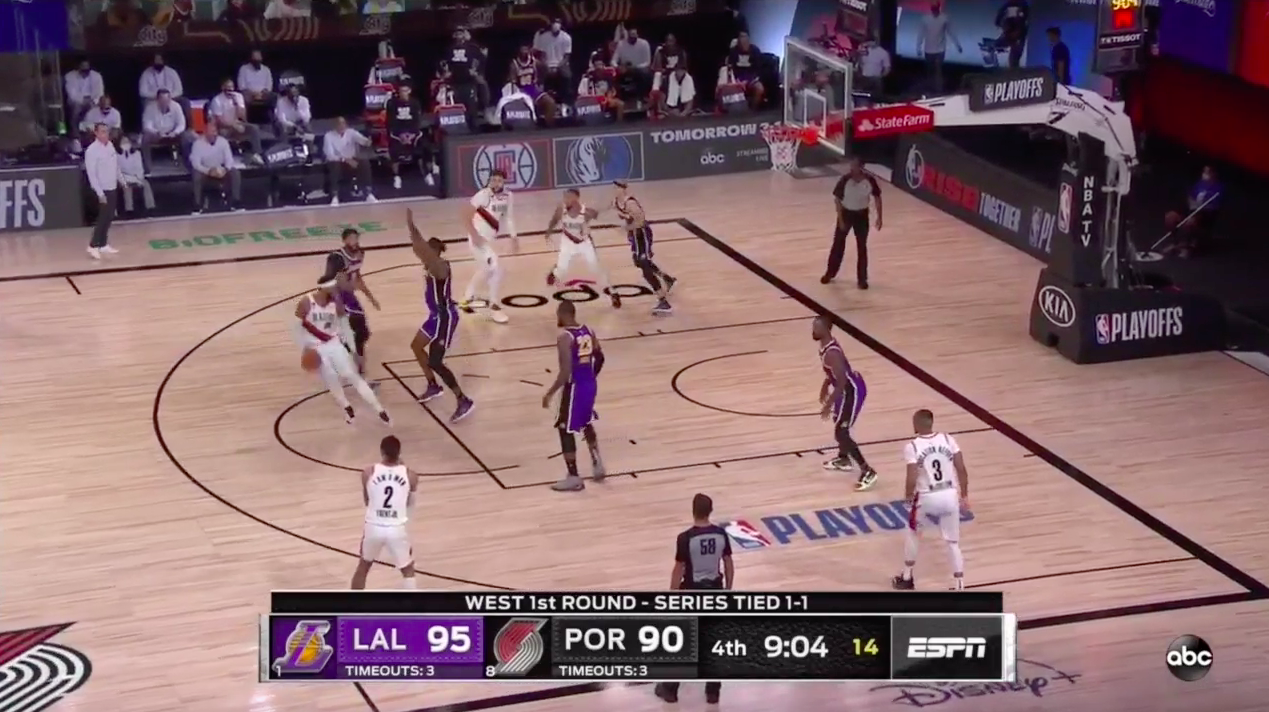
If Dame were to get open on that screen, that’s good offense for Portland. With LA hard hedging there’s no chance for Caruso to call out a switch. As long as LA hedges, one of those two options will be available. If they switch, Nurkic has inside position on AD to slip to the rim. If there’s no hedge, Melo gets an open 3-point shot.
I’d probably just switch and force Melo to make that pass to the slip with Dame and AC also in the vicinity, so the play is by no means unguardable. But LA didn’t show they could guard it, so I’m not sure why Portland decided to back off from pressing the advantage they had found.
AGAIN, Portland has found something that’s worked this series (like the top locking in game 1 and step up screens and handoffs in game 2) and gone away from it before the Lakers proved they could adjust. In that sense, Portland is beating itself.
Nurkic Short Roll
The short roll, as we’ve covered before, is one key area LA’s hard hedge ball screen coverage gives up. Portland has 4 on 3 scenarios pretty much as often as they want, but haven’t been able to take advantage.
As I covered in this video, Nurkic is the issue, and really the key to this series that enables LA to continue doing what they’re doing to shut down Portland’s offense.
In game 3, Nurkic had 11 short rolls. He shot 2/8, with his two makes coming once when he was at the rim when he caught the ball and once when LA had a miscommunication by LeBron and Morris and Nurkic drive to the rim with ease.
In terms of his passing, he had one turnover attempting to pass, one assist where he passed too early and the defender recovered easily to Whiteside (who scored anyways after a post spin move), and one time he made a good pass for a corner 3 attempt by Hezonja after taking 1 dribble toward the rim to draw AD to him and make the closeout to the corner further.
Overall, that’s 6 points on 11 possessions (0.55 PPP), which I’m happy with from the Laker point of view.
LA’s 1.5 Man Coverage
Portland scored 3 points on 5 possessions in game 3 facing what I’ve been calling the 1.5 man coverage and covered in previous articles. The one time they did score, Simons was critical in driving to further break down the defense, then pass the ball out for a shot. He took a small advantage and turned it into a big advantage on that possession for Portland.
Portland didn’t have success, for the third game in a row, trying to just pass the ball around while standing still to get to a shot. LA was able to recover well in those situations, and being able to leave players like Nurkic or Simons (D+ 3PT Shot Making rating in our data) on the perimeter helped simplify rotations as long as those players were standing on the perimeter and not scoring threats or going to the rim with the ball in their hands.
Gary Trent & Carmelo Anthony
For the third game in a row, we saw broken possessions where the pass out from a pick & roll wasn’t to an open Trent/Melo after breaking down the defense, but to a contested one because the Lakers negated the pick and roll, who then needed to try to create their own shot before the shot clock ran out.
We also saw “vintage Melo,” during a stretch in the 3rd quarter where he hit three mid range self-created shots in a row. We also saw Gary Trent get an “and 1” on a pick and roll attack. Yet, both players ended up with their third game in a row of inefficient self-creation offense.
Melo
- 13 pts 17 poss
- 3 pts 2 poss
- Putback
- Transition leak out dunk
Series update:
Melo Update
Self-Creating
Game 1: 3 points in 10 possessions
Game 2: 5 pts 17 poss
Game 3: 13 pts 17 possFinishing
Game 1: 6 pts 5 poss
Game 2: 6 pts 6 poss
Game 3: 3 pts 2 possI'm loving that 3.3 to 1 ratio if I'm the Lakers.
— Cranjis McBasketball (@Tim_NBA) August 24, 2020
Trent
- 3 pts 4 poss self-creating
- 3 pts 2 poss finishing
Series update:
Trent Update
Self-Creating
Game 1: 2 pts 5 poss
Game 2: 2 pts 10 poss
Game 3: 3 pts 4 possFinishing
Game 1: 3 pts 4 poss
Game 2: 9 pts 7 poss
Game 3: 3 pts 2 poss~1.5 ratio for Trent of possession types. 0.37 PPP vs 1.15 PPP efficiency.
Direct result of POR P&R not working. https://t.co/uBq9MeUkDj
— Cranjis McBasketball (@Tim_NBA) August 24, 2020
This will continue as long as LA keeps Portland’s P&R negated with their hard hedges and Nurkic can’t do anything in the short roll. But if Portland adjusts there, we’ll likely see the open catch & shoot jumpers start flowing again and Portland’s offense get a big boost.
What hasn’t been giving Portland that boost is Dame Lillard’s isolation offense.
Dame is shooting 20% in isolation these playoffs. He's also not getting into the paint almost at all to be able to create easy offense for their shooters.
Melo (15%) and Butler (11%) are the only players shooting worse in the playoffs.
Alex Caruso, man. What a series so far.
— Cranjis McBasketball (@Tim_NBA) August 24, 2020
We saw game 3 feature adjustments to get higher volumes of isolation offense from Dame and CJ. Those 13 possessions combined scored 12 points, which isn’t anything spectacular. But even when it was working, Portland wasn’t breaking down the defense with drives and creating open looks for other players. Those isolation looks were primarily shots from the perimeter, whether from 2 or 3. This furthers my belief that we won’t be seeing easy offense for Melo or Trent unless Portland’s pick and roll attack improves.
Laker Offense
LA’s offense cleaned up their mistakes and had a strong third quarter power the team to victory. We saw Alex Caruso drive by his man and get to the rim a half dozen times after dead balls or made baskets, collapsing the defense for kick outs and good shots.
Lebron & Davis Pick & Roll
After 12 scoring possessions from the pick and roll in game 1 that dropped to just 3 in game 2, LA had 8 scoring possessions and scored 10 points. They burned hard hedges (8 points in 5 possessions) with pops from AD or LeBron pulling up if his man went under the screen, and got to the rim to score against a small Blazers lineup that ran a drop.
What didn’t result in points were the two times the Blazers switched the action. This has been the weakness of the Bron/AD pick and roll all season, and we saw that in game 1 as well. It’s baffling to me why Portland didn’t shift their ball screen coverages more towards switches and away from what LA has shown all season and also in this series that they can beat.
Adding in twice he did it with Dwight as his screener, LeBron took pull up 3-pointers behind the ball screen while his man went under three different times this game and went 2/3 on those shots.
Non-Bron attacks
We didn’t see the Kuzma or AD ball screens like we did in game 2, but LA did find something else that worked well. 18 points in 11 possessions for a blistering 1.63 points/possession efficiency played a big role in helping LA win game 3. Portland threw just about every possible coverage at this duo over the course of the game, but it didn’t seem to matter.
Caruso got things going as a scorer:
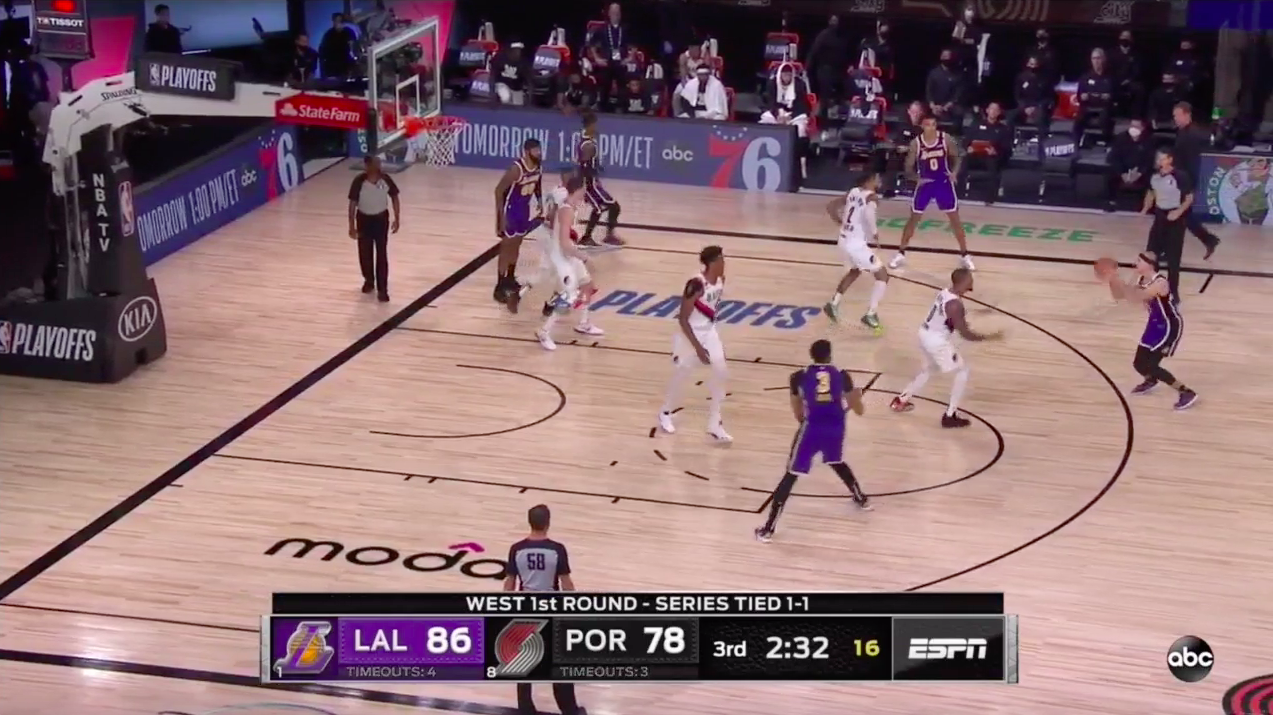
And also as a passer, making the simple pick & pop reads afforded to him by pairing with AD. He’s not the kind of player that’ll consistently make, or even attempt, more complex reads to identify tags or not and hit the right player with a pass, but he can make passes like these all day long:
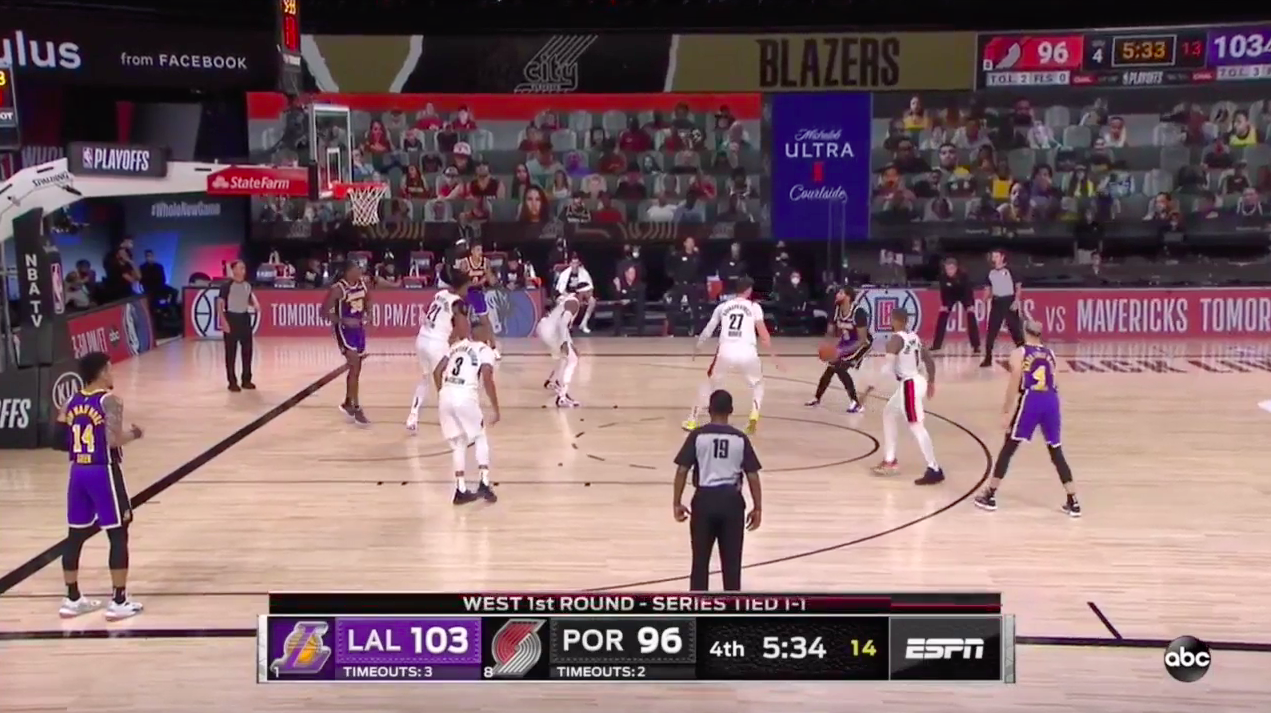
The two also have the chemistry and understanding to run inverted pick & rolls, as they execute here against a small defense with no second rim protector, getting AD a 3-point play.
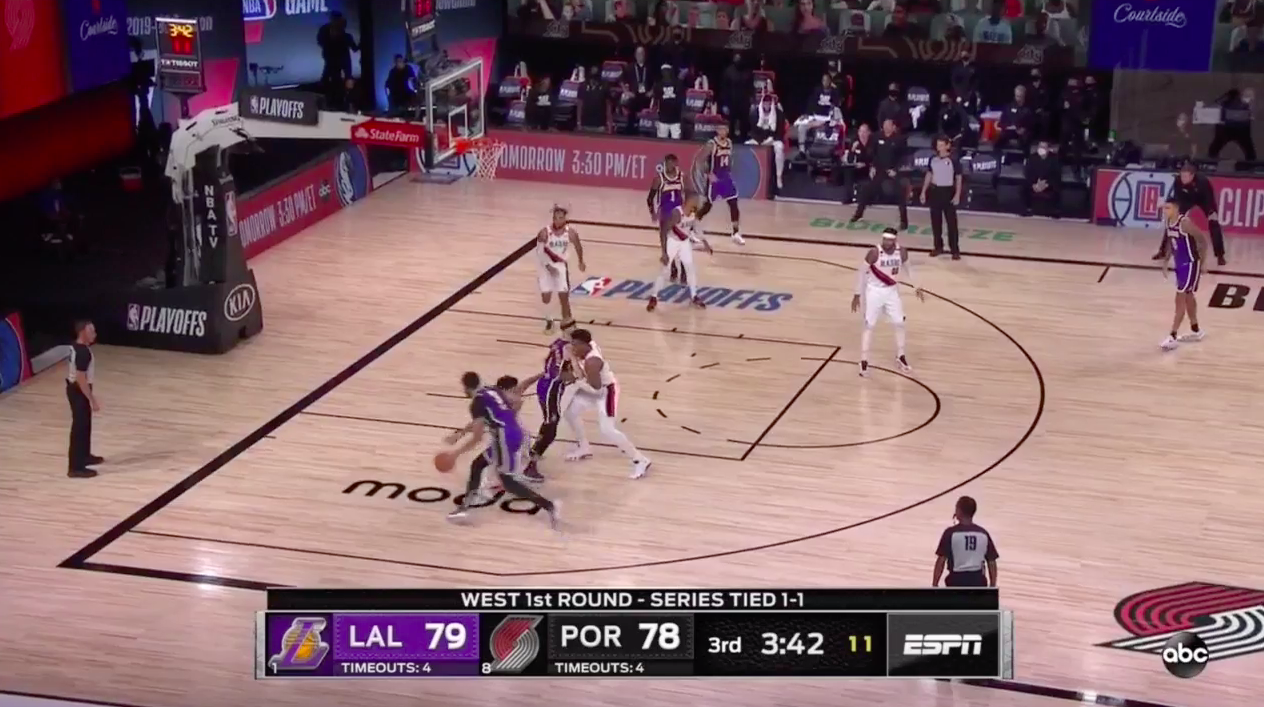
Attacking the 2-3 Zone
One item we covered last game as a needed adjustment for the Lakers was attacking Portland’s 2-3 zone in out of bound situations. Overall, LA has shot just 2/7 against Portland’s zone in the series, but this game they found a set that worked to get them at least open mid range 2-point looks. The idea was better than the execution, with the man AD was sealing off able to fight through by the time the shot actually gets off, but LA at least had some organization on this one.
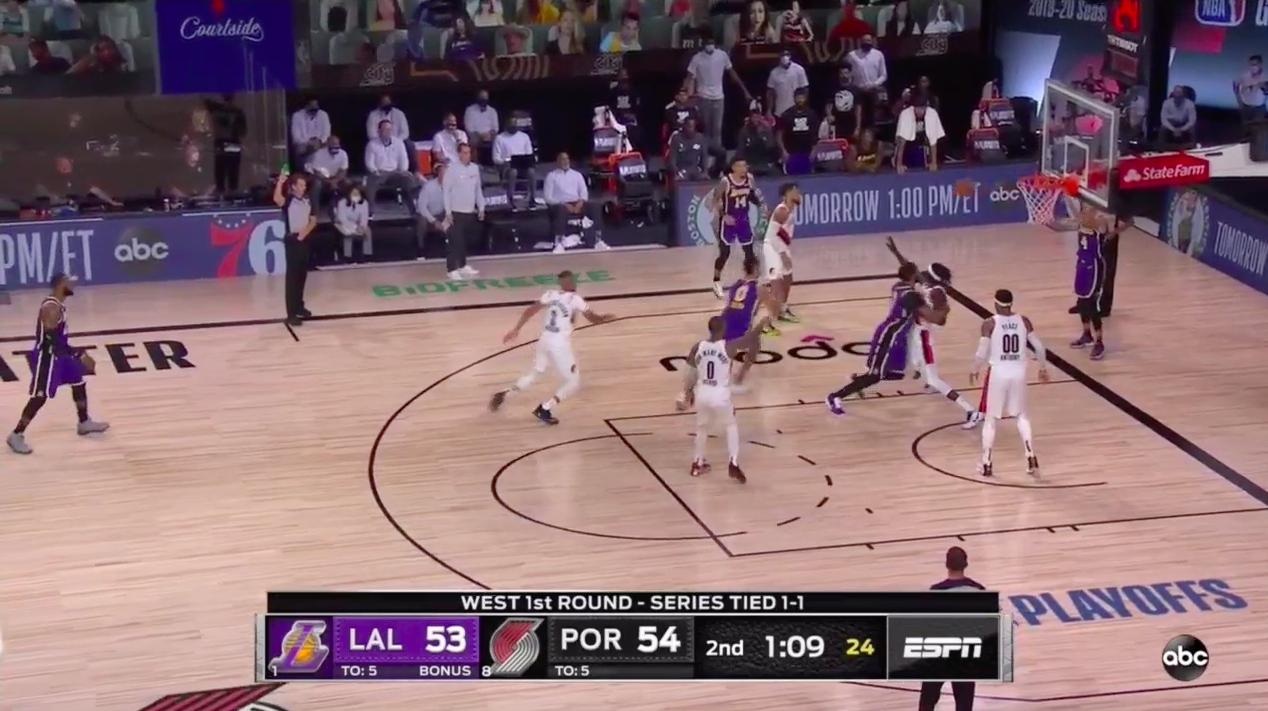
LeBron as a Screener
As we’ve covered before, LeBron as a screener can be a strong weapon for the Lakers to get his teammates easy looks. Because Portland doesn’t want to help off of him, setting screens and preventing a hedge gives LA the same looks Portland desperately wants to obtain in their pick & roll game, but whenever LA wants. This extends to not helping to clog up the paint, as we covered in the game 2 post-game article.
This game, we saw this yet again on a handoff for Caruso. LA should use more of this offense whenever they need to get some attacks downhill.
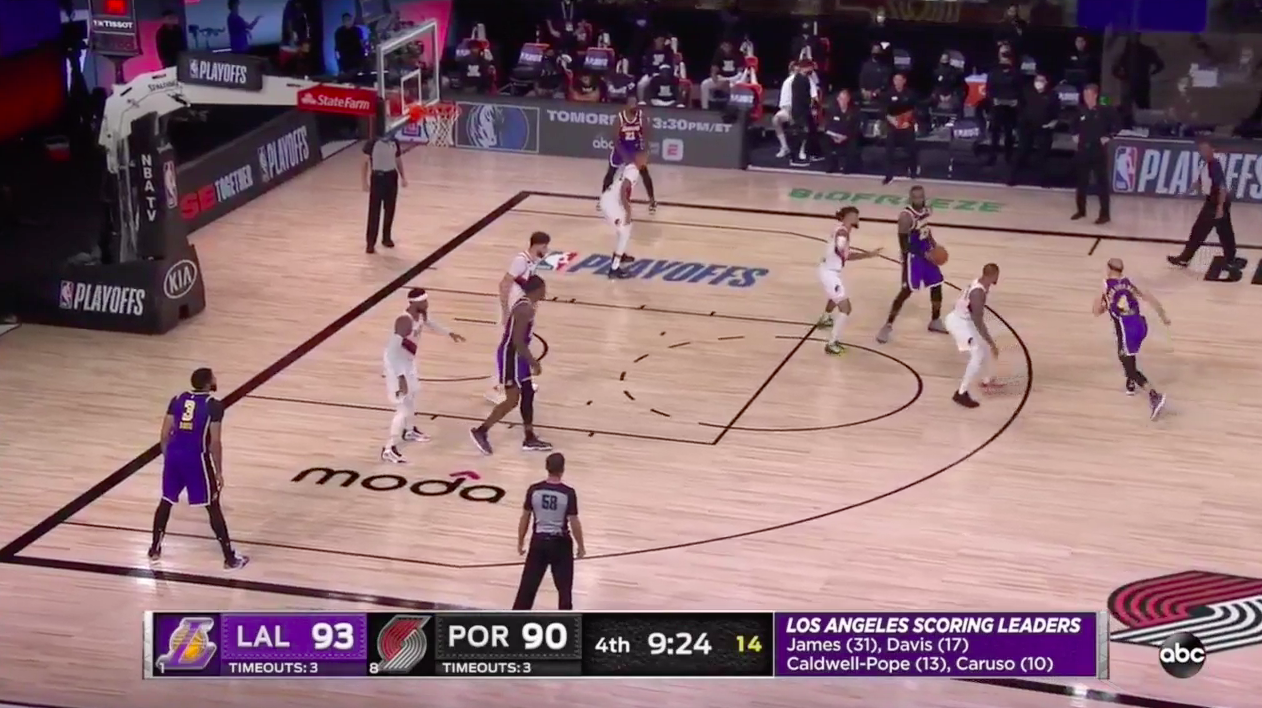
LA Going Small
With Dudley on-court minutes (as a proxy for garbage time) removed, here’s how the Lakers’ offense changed from a frequency and efficiency standpoint once going small for the series:
| Small Lineups | Non-Small Lineups | Difference Going Small | ||||
| Play Type | Freq% | PPP | Freq% | PPP | Freq% | PPP |
| Spot Up | 19% | 0.68 | 26% | 0.76 | -7% | -0.08 |
| Transition | 18% | 0.75 | 19% | 0.72 | -1% | 0.03 |
| P&R BH | 21% | 1.00 | 11% | 0.87 | 10% | 0.13 |
| Putbacks | 8% | 1.27 | 9% | 0.94 | -1% | 0.33 |
| Isolation | 7% | 1.00 | 7% | 0.71 | 0% | 0.29 |
| Cuts/Dump Offs | 6% | 1.63 | 7% | 1.47 | -1% | 0.16 |
| Misc | 5% | 0.57 | 6% | 0.33 | -1% | 0.24 |
| Rolls/Pops/Slips | 6% | 0.75 | 5% | 0.82 | 1% | -0.07 |
| Post Up | 7% | 1.11 | 3% | 0.83 | 4% | 0.28 |
| Handoff | 2% | 1.50 | 3% | 1.43 | -1% | 0.07 |
| Off Screen | 1% | 0.00 | 4% | 0.88 | -3% | -0.88 |
| Total | 0.92 | 0.84 | 0.09 | |||
When LA’s lineups went small, their attack went big. More post ups at a heightened efficiency, the team’s efficiency on putbacks went up, and the isolation play was suddenly much easier. Along with that, the pick & roll attack got going at a much higher frequency along with a higher efficiency.
And here’s how Portland’s offense performed against those small Laker lineups vs their bigger ones:
| Vs LA’s Small Lineups | Vs LA’s Non-Small Lineups | Difference Going Small | ||||
| Play Type | Freq% | PPP | Freq% | PPP | Freq% | PPP |
| P&R BH | 17% | 1.23 | 19% | 0.83 | -2% | 0.40 |
| Transition | 12% | 1.06 | 14% | 1.38 | -2% | -0.32 |
| Spot Up | 22% | 0.89 | 14% | 0.68 | 8% | 0.21 |
| Isolation | 15% | 0.37 | 12% | 0.95 | 3% | -0.59 |
| Cuts/Dump Offs | 5% | 1.14 | 9% | 1.12 | -4% | 0.03 |
| Handoff | 3% | 0.75 | 7% | 0.58 | -4% | 0.17 |
| Post Up | 7% | 0.78 | 6% | 0.64 | 1% | 0.14 |
| Putbacks | 3% | 0.50 | 6% | 1.55 | -3% | -1.05 |
| Rolls/Pops/Slips | 4% | 0.00 | 5% | 0.50 | -2% | -0.50 |
| Off Screen | 2% | 1.50 | 4% | 0.71 | -2% | 0.79 |
| Misc | 11% | 0.14 | 3% | 1.00 | 7% | -0.86 |
| Total | 0.78 | 0.93 | -0.15 | |||
From this, we see LA getting more efficient on offense and holding Portland’s offense down defensively. Portland not getting dump offs, roll man possessions, or putbacks and needing to resort to isolation more (at a decreased efficiency) helped get there.
Plays like this helped get LA to those marks. Here, we see LA take advantage of Portland having just one rim protector by getting him involved in a decoy pick & roll action, then attacking through a LeBron post up at the rim with no help coming:
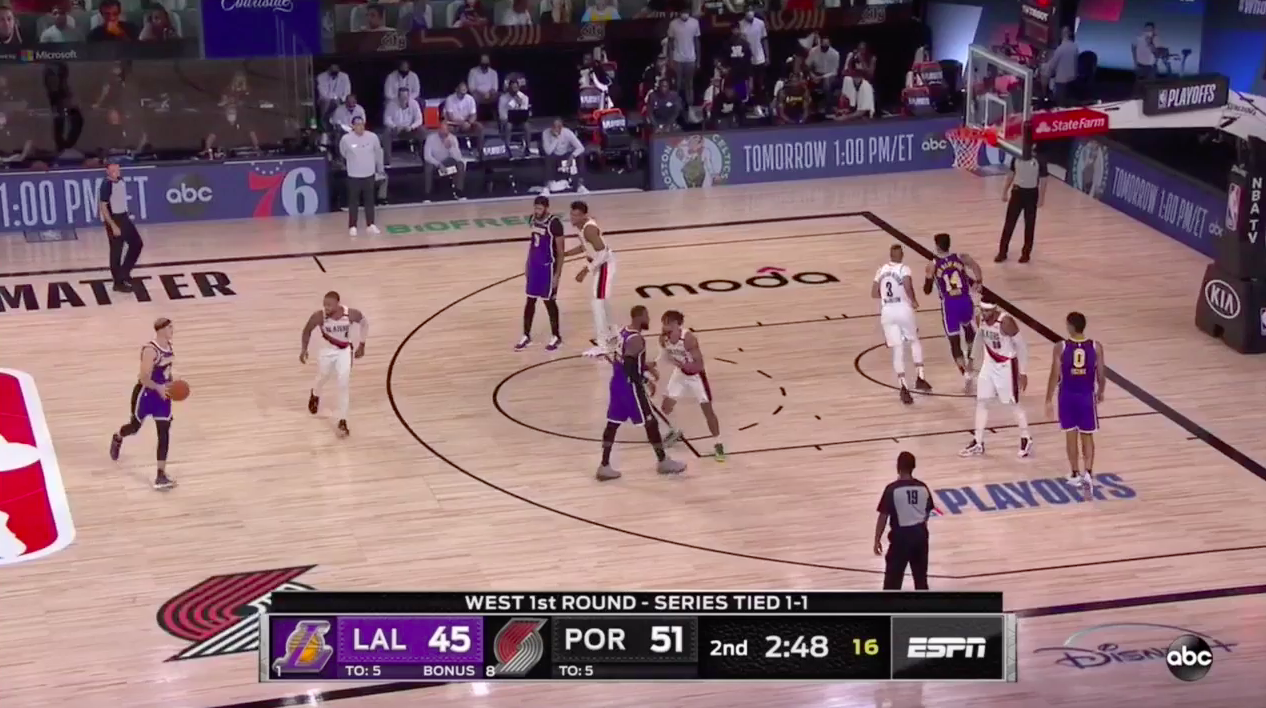
When Portland went small, suddenly lanes opened up and LeBron wasn’t met with a 7’0” wall after driving past Gary Trent Jr., as has happened often this series:
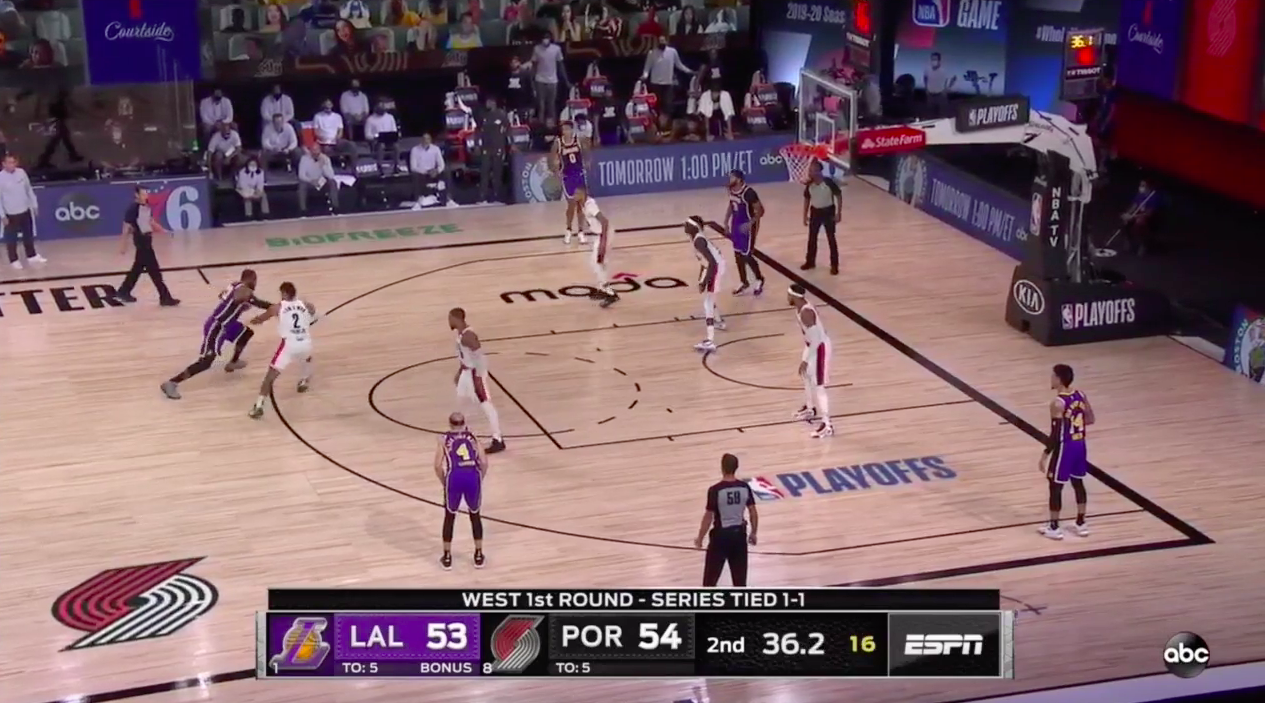
LeBron being guarded by a slower footed shot blocker on the perimeter meant he could actually finish at the rim, instead of being met with a second one and needing to kick out.
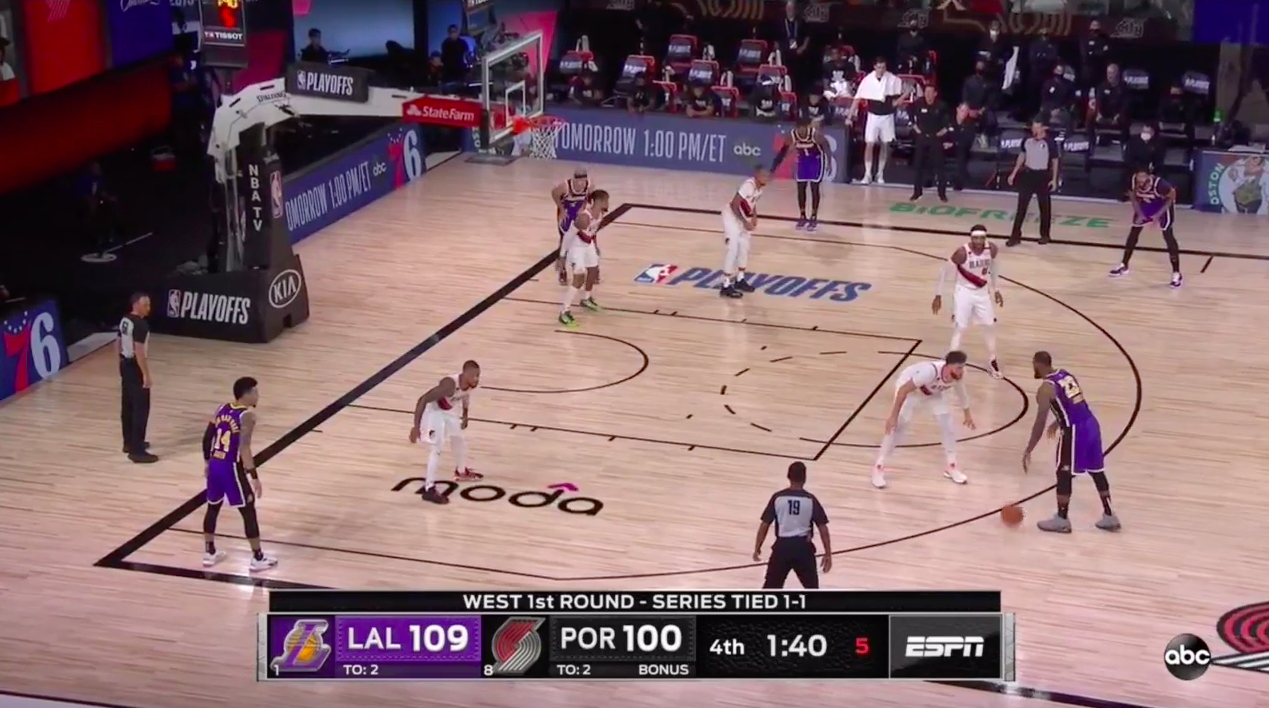
With all of that, LA in game 3 still only had 10 points on 11 post up isolation possessions by LeBron and AD. Most came against bigger Portland lineups in game 3. When LA did go small, they turned their focus instead to the pick and roll attack, adding 10 quick points on 6 scoring possessions between Caruso, LeBron, and AD.
Whether it be attacking driving lanes, bullying Portland on the glass, or isolating with less traffic, the smaller Lakers have advantages over Portland we’ve seen for 3 games in small spirts that LA can turn to more if they want in the remaining games against the Blazers.
And we can be seeing much more of this if LA wants. The Lakers have gone small less and less each game this series, with AD’s minutes at the center position dropping from 58% in game 1 to 50% in game 2 to 40% in game 3. LA has a clear advantage playing big while going small, so hopefully we’ll see more of it in game 4.
Portland’s Adjustments:
- To remove hedges in ball screens
- Step up ball screens – ran only 3 times. Also had a couple more times where they just completely whiffed. Could’ve used much more.
- Handoffs – tried handoffs, since in game 2 they yielded situations where there wasn’t a hedge. They went back to that 3 times in game 3, but LA adjusted well with hedges this game and POR didn’t get success from this.
- Used a set play to attack the fact LA did start hedging on handoffs (or get open shots if they didn’t). Ran 3 times but didn’t go back to it.
- Ram action – Portland ran this once in Q2 and Melo jogged into the ball screen so Portland gained no advantage. They didn’t go back to it.
We saw Portland run "Ram" action on their ball screens once all game, where CJ set a down screen for Melo before Melo went to set the ball screen for Dame.
Because Melo did a slow jog into the ball screen it yielded no advantage at all.
Portland went back to it 0 times in Q3-4.
— Cranjis McBasketball (@Tim_NBA) August 24, 2020
- Get isolations for Dame & CJ
- Attack early in possessions before the defense could get set
- Get Nurkic off the court so the 1.5 coverage didn’t work
- String out hard hedges to turn them into isolations
- Use Melo P&P to get switches and then isolate
LA’s Adjustments:
- Attacking 2-3 zone a bit better
- Gave up attacking packed paint to attack with P&R. Particularly with Caruso/AD pick & pops
- Attacking packed paint on drives vertically w/lobs
- Used step up ball screens to get LeBron going downhill
Possible Adjustments for Game 4:
Portland: get your pick & roll attack going to unlock your offense
- Butt screens, where the screen is set behind the ball handler’s man rather than on a particular side. This would make hard hedging a guessing game and might force LA to switch coverages.
- Flip ball screens, where they let LA hard hedge and then reset the screen to go the other way away from the hedge.
- Use more of that handoff into a down screen play until LA adjusts to it
- Design more pick & rolls to get the roll man (Nurkic) deeper before he gets the pass, making his job easier. You can do this with “logo” ball screens set where the logo is on the baseline on the court.
- Have ball screens similar to the handoff play, where the screener goes into setting a down screen after setting the ball screen.
- Run off-screen action as soon as you pass to Nurkic on a pop. A split cut, for example, might give multiple looks to Nurkic, who can make those passes, and he’d be able to do so without being disrupted on-ball with pressure the way LA has in previous games to negate Portland’s sets using him as a trigger man.
Portland: take advantage of Laker double teams you know are coming.
- Set pin-in flare screens or cut against Nurkic post doubles, which have come every time when he’s guarded by anyone but an LA big. Same w/Melo iso doubles.
LA: open the paint
- LeBron as a screener means no hedge on ball screens for other players, opening driving lanes
- Weak side action can engage would-be help defenders and make it easier to attack in isolation, the post, or in the pick and roll.
- Refer to my last piece for more recommendations around this.
- Going small also solves this problem by working around it, but it’s more a workaround than a solution. We’ll likely need solutions for LA to win the title this year, because they can’t play small all the time against everyone.
LA: Get AD attacking downhill off a live dribble
- Pick and roll for him gets some of this, but might make for tough reads.
- Pick and roll with high step up ball screens where he has plenty of space to get a head of steam would be a step up from a normal ball screen.
- Inverted ball screens also help.
- AD running off of pin down screens or AI action also generate some of these looks. LA tried down screens twice against Portland’s twin towers lineup to take advantage of their lack of willingness to get on the perimeter with help defense.

